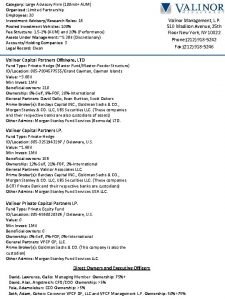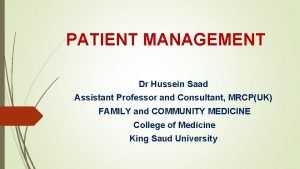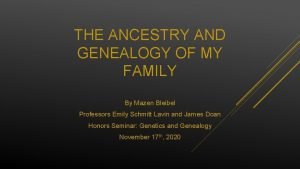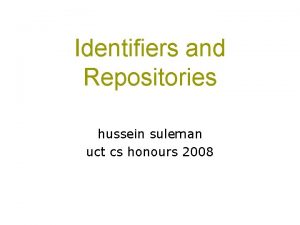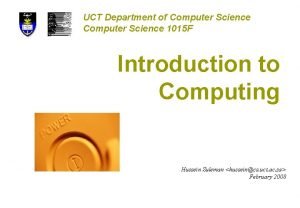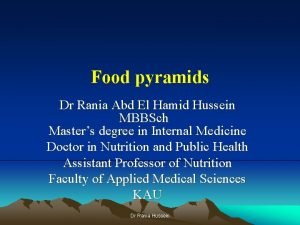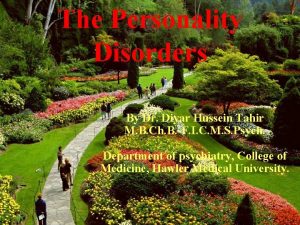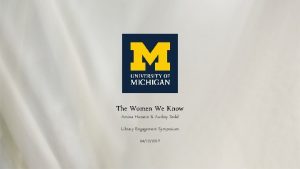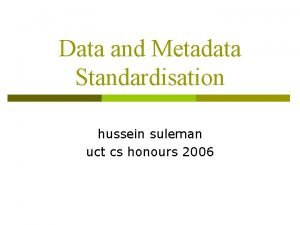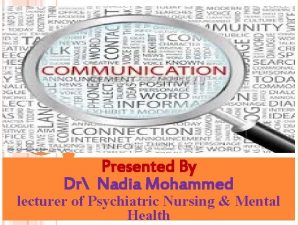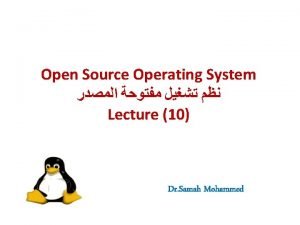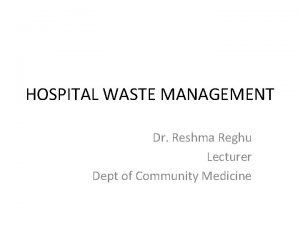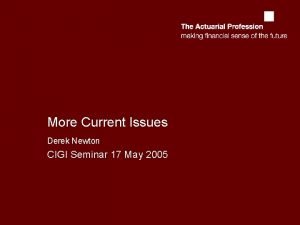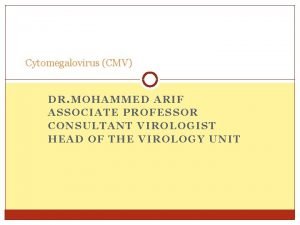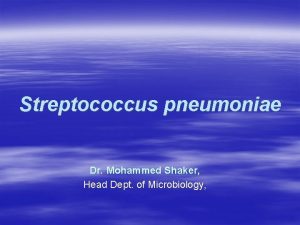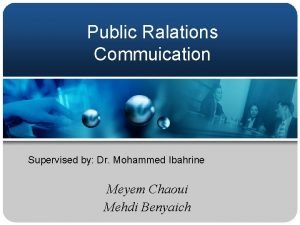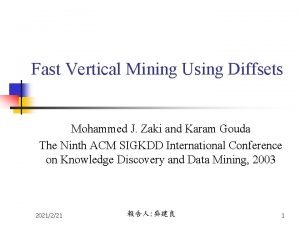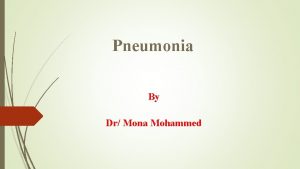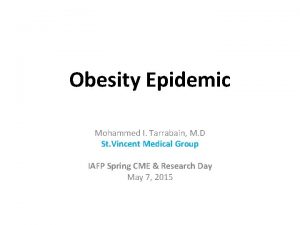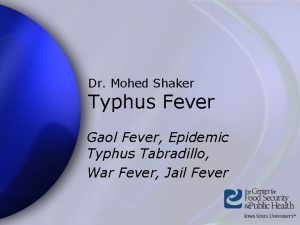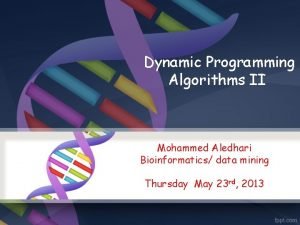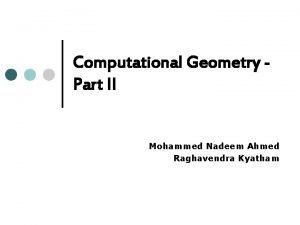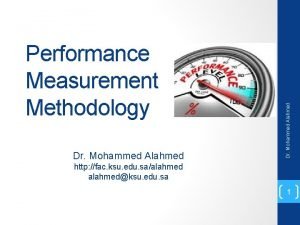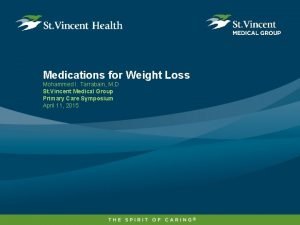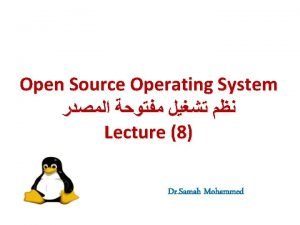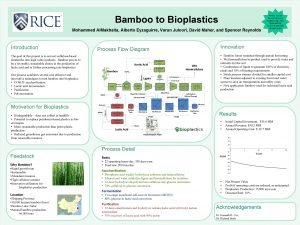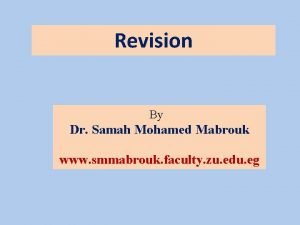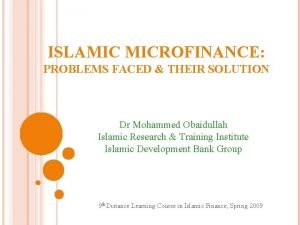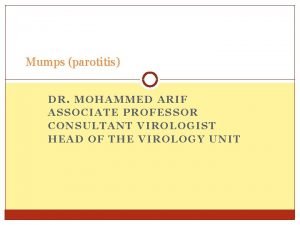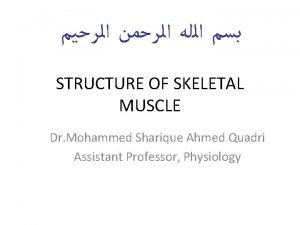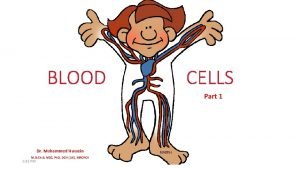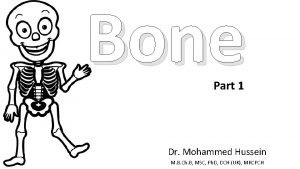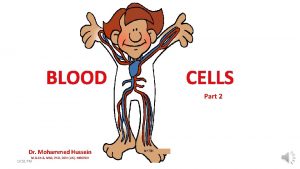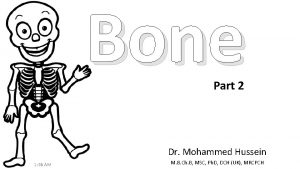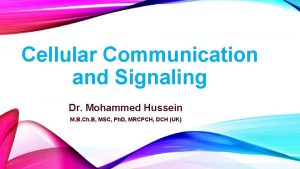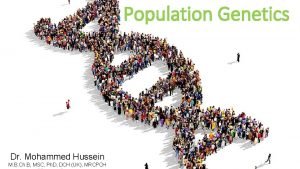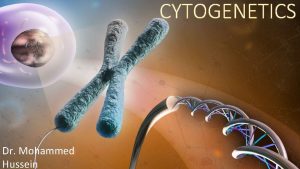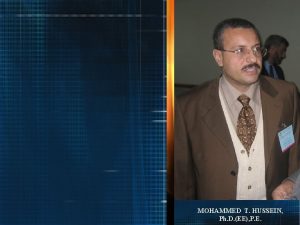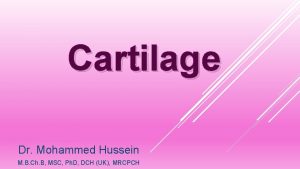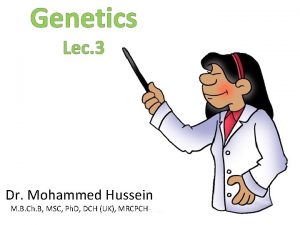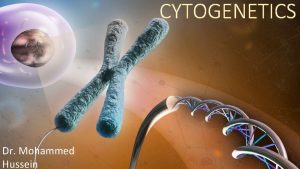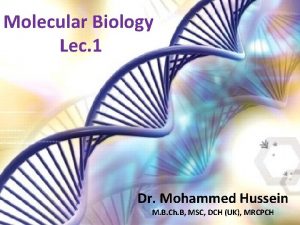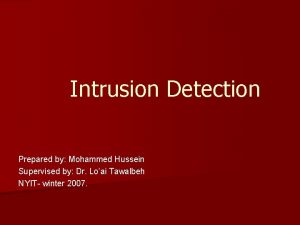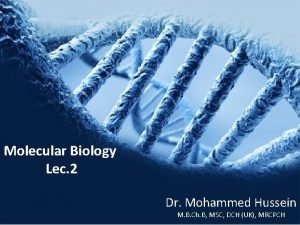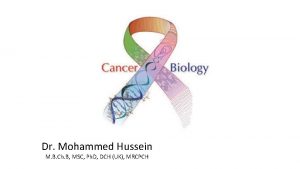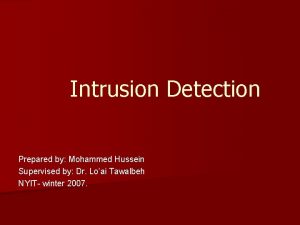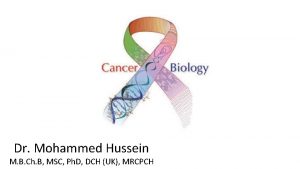Part 1 11 31 PM Dr Mohammed Hussein





























































- Slides: 61

Part 1 11: 31 PM Dr. Mohammed Hussein

• Introduction • Numerical Chromosomal Abnormalities • Structural Chromosomal Abnormalities • Advances in Molecular Cytogenetics 11: 31 PM

Introduction 11: 31 PM

• Chromosome abnormalities are: • Seen in 1 /150 live births • The leading known cause of mental retardation • The leading known cause of pregnancy loss – 50% of fetal losses during the first trimester of pregnancy – 20% of fetuses lost during the second trimester of pregnancy 11: 31 PM

Karyotyping 11: 31 PM

Karyotyping • Chromosomes are most easily visualized during the metaphase stage of mitosis, when they are maximally condensed • They are photographed under the microscope to create a karyotype • Karyotype is an ordered display of the 23 pairs of human chromosomes in a typical somatic cell 11: 31 PM

11: 31 PM

11: 31 PM

Karyogram • Karyogram represents a drawing of each type of chromosome • The presentation is haploid (only one copy of each chromosome is shown) 11: 31 PM

11: 31 PM

Chromosome Banding • To visualize chromosomes in a karyotype, various stains are applied so that banding is evident • G-banding: Mitotic chromosomes are partially digested with trypsin (to digest some associated protein) and then stained with Giemsa, a dye that binds DNA 11: 31 PM

X p 2 2. 1 X q two-two point one NOT X q twenty-two point one 11: 31 PM

Chromosome Nomenclature 11: 31 PM

q. Metacentric chromosomes: have the centromere near the middle q. Submetacentric chromosomes: have the centromere displaced toward one end q. Acrocentric chromosomes: have the centromere far toward one end 11: 32 PM

Acrocentric Chromosomes • Have the centromere far toward one end • Chromosomes 13, 14, 15, 21, and 22 • Only the acrocentric chromosomes are involved in Robertsonian translocations 11: 32 PM

Mnemonic • Acrocentric chromosomes • 1, 2, 3, 4, 5 • 21, 22, 13 , 14 , 15 11: 32 PM

Common Symbols Used in Karyotype Nomenclature 1 -22 X, Y (+) or (–) p q t del inv i r 11: 32 PM Autosome number Sex chromosomes When placed before an autosomal number, indicates that chromosome is extra or missing Short arm of the chromosome Long arm of the chromosome Translocation Deletion Inversion Isochromosome Ring chromosome

11: 32 PM

• 46, XY Normal male • 46, XX Normal female • 47, XY, +21 Male with extra chromosome no. 21 (Trisomy 21) (Down syndrome) • 47, XX, +13 Female with extra chromosome no. 13 (Trisomy 13) (Patau syndrome) • 45, XX, – 13 Female with missing chromosome no. 13 (Monosomy 13) • 47, XX, +18 Female with extra chromosome no. 18 (Trisomy 18) (Edward syndrome) • 47, XXY Male with extra X chromosome (Klinefelter syndrome) • 45, X Female with missing X chromosome (Turner syndrome) • 46, XY, t(2 p; 8 p) Male with translocation between short arms of chromosomes 2 & 8 • 46, XY, del(5 p) Male with deletion in short arm of chromosome 5 (Cri Du Chat syndrome) • 46, X, r(X) Female with ring chromosomes X (Turner syndrome) 11: 32 PM

Chromosome Abnormalities 1. Numerical Chromosomal Abnormalities 2. Structural Chromosomal Abnormalities 11: 32 PM

Numerical Chromosome Abnormalities • Polidy : is the no. of the sets of chromosomes in the cell • Euploid: When a cell has a multiple of 23 chromosomes, it is said to be euploid. • Haploid: 1 set of 23 chromosome (gametes) • Diploid: 2 sets of 23 chromosomes (46) (somatic cells) • Triploidy: 3 sets of 23 chromosomes (69) • Tetraploidy: 4 sets of 23 chromosomes (92) 11: 32 PM

Triploidy 11: 32 PM

Triploidy • Result of the fertilization of an ovum by two sperm cells • Is common at conception, but the vast majority of these conceptions are lost prenatally • However, about 1 in 10, 000 live births is a triploid • These babies have multiple defects of the heart and central nervous system, and they do not survive 11: 32 PM

Tetraploidy 11: 32 PM

Tetraploidy • This lethal condition is much rarer than triploidy among live births • Only a few cases have been described 11: 32 PM

Aneuploidy 11: 32 PM

Aneuploidy • Aneuploidy, a deviation from the euploid number, represents the gain (+) or loss (–) of a specific chromosome • Two major forms of aneuploidy are observed: – Monosomy (loss of a chromosome) – Trisomy (gain of a chromosome) 11: 32 PM (–) (+)

Aneuploidy • Autosomal aneuploidy – Monosomy (–) – Trisomy (+) • Sex chromosome aneuploidy – Monosomy (–) – Trisomy (+) 11: 32 PM

Autosomal aneuploidy 11: 32 PM

Autosomal aneuploidy • All autosomal monosomies are inconsistent with a live birth • Only three autosomal trisomies are consistent with a live birth – Trisomy 13 – Trisomy 18 – Trisomy 21 11: 32 PM

Trisomy 13 (Patau Syndrome) • 47, XY, +13 or 47, XX, +13 11: 32 PM

11: 32 PM

Trisomy 18 (Edward Syndrome) • 47, XY, +18 or 47, XX, +18 47, XY, +18 11: 32 PM

11: 32 PM

Trisomy 21 (Down Syndrome) • 47, XY, +21 or 47, XX, +21 11: 32 PM

11: 32 PM

11: 32 PM

11: 32 PM

Sex chromosome aneuploidy 11: 32 PM

Sex chromosome aneuploidy • Relatively common • Have less severe consequences than does autosomal aneuploidy. 11: 32 PM

Some generalizations are helpful • If a Y chromosome is present, the phenotype is male (regardless the no. of X ) • 46, XY = Male • 46, XX = Female • 45, XO = Female (Turner) • 47, XXY = Male ( Klinefelter) 11: 32 PM

Some generalizations are helpful • One X chromosome is required for survival and any other X will become a Barr body • 46, XX = • One Bar body • 46, XY = • No Bar body • 45, XO = • No Bar body • 47, XXY = • One Bar body • 47, XXX = 11: 32 PM • Tow Bar bodies

Sex chromosome aneuploidies • Extra X chromosome: – Male with extra X = 47, XXY – Female with extra X = 47, XXX • Extra Y chromosome – Male with extra Y = 47, XYY • Missing X chromosome: – Female with missing X = 45, X or 45, XO 11: 32 PM

Klinefelter Syndrome 47, XXY 11: 32 PM

11: 32 PM

11: 32 PM

Turner Syndrome 45, X 11: 32 PM or 45, XO

11: 32 PM

Linda Hunt 11: 32 PM

Triple X Syndrome 47, XXX 11: 32 PM

11: 32 PM

• • • Other rare Sex chromosome aneuploidies: XXY Syndrome (47, XXY) XXYY Syndrome (48, XXYY) XXXX Syndrome (48, XXXX) or Tetrasomy X XXXXX Syndrome (49, XXXXX) or Pentasomy X 11: 32 PM

Nondisjunction is the usual cause of aneuploidies 11: 32 PM

Disjunction during Meiosis I 11: 32 PM Disjunction during Meiosis II

Non-disjunction during Meiosis I 11: 32 PM Disjunction during Meiosis II

Disjunction during Meiosis I 11: 32 PM Non-disjunction during Meiosis II

Some important points to remember: • Nondisjunction is the aneuploidies including: usual – Down syndrome (Trisomy 21) – Edward syndrome (Trisomy 18) – Patau syndrome (Trisomy 13) – Turner syndrome (Monosomy X) – Klinefelter syndrome (Extra X) 11: 32 PM cause of

Some important points to remember • Nondisjunction is more likely to occur during oogenesis than during spermatogenesis. 11: 32 PM

Some important points to remember • Nondisjunction is more likely with increasing maternal age. • No environmental agents (e. g. , radiation, alcohol) have been shown to have measurable influence. 11: 32 PM

Some important points to remember • Nondisjunction is more likely in meiosis I than meiosis II. 11: 32 PM

11: 32 PM
 Anichya gujral
Anichya gujral Dr hussein saad
Dr hussein saad Bleibel
Bleibel Reporaproblem
Reporaproblem Advantages of selective primary health care
Advantages of selective primary health care Hassine bey
Hassine bey Bassam hussein
Bassam hussein Hussein suleman
Hussein suleman George h w bush apush
George h w bush apush Ananda sabil hussein
Ananda sabil hussein Dr. hussein shaqra
Dr. hussein shaqra Mbbsch
Mbbsch Taha hussein challenges
Taha hussein challenges Alhamdu lillahi
Alhamdu lillahi Nadya hussein
Nadya hussein Hussein suleman
Hussein suleman Saddam hussein
Saddam hussein Rania hussein
Rania hussein Saddam hussein
Saddam hussein Laila hussein
Laila hussein Emptiness
Emptiness Amina hussein height
Amina hussein height Hussein suleman
Hussein suleman Saddam hussein
Saddam hussein Karen hussein
Karen hussein Hussein suleman
Hussein suleman Natisod in english
Natisod in english Ecolima pathway
Ecolima pathway Mohammed airaj
Mohammed airaj Dr mohammed shaker
Dr mohammed shaker Nadia mohammed
Nadia mohammed Dr samah mohammed
Dr samah mohammed Dr reshma mohammed
Dr reshma mohammed Armoghan mohammed
Armoghan mohammed Prof mohammed arif
Prof mohammed arif Pneumococci
Pneumococci Coco turkie
Coco turkie Public ralations
Public ralations Tidset
Tidset Aleem mohammed
Aleem mohammed Mohammed mona md
Mohammed mona md Dr mohammed tarrabain
Dr mohammed tarrabain Gaol fever definition
Gaol fever definition Mohammed's scimitar
Mohammed's scimitar Mohammed airaj
Mohammed airaj Mohammed aledhari
Mohammed aledhari Mohammed ashfaq ahmed
Mohammed ashfaq ahmed Dr mohammed ahmed
Dr mohammed ahmed Yitzhak rabin
Yitzhak rabin Httpfac
Httpfac Emaptic
Emaptic Source
Source Mohammed houssein kamali
Mohammed houssein kamali Mohammed bamboo
Mohammed bamboo Mohammed el husseiny
Mohammed el husseiny Dr samah mohammed
Dr samah mohammed Dr mohammed obaidullah
Dr mohammed obaidullah Mohammed yusuf (boko haram)
Mohammed yusuf (boko haram) Rahaf mohammed video
Rahaf mohammed video Professor mohammed arif
Professor mohammed arif Difference between troponin and tropomyosin
Difference between troponin and tropomyosin Mohammed
Mohammed
